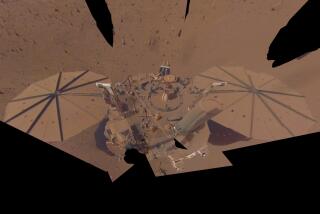Odyssey Probe Detects Vast Ice Deposits on Red Planet
- Share via
WASHINGTON — The Mars Odyssey space probe now circling the Red Planet has detected extensive deposits of ice in a thick layer 2 feet beneath the surface, helping solve the mystery of where the planet’s once extensive bodies of water may have gone, NASA scientists reported Tuesday.
Scientists are jubilant about the find because the detection of water so close to the surface--even frozen--bodes well for the search for traces of past or present life on Mars.
“Where there’s water, there’s life,” said R. Stephen Saunders, the project scientist for the Jet Propulsion Laboratory’s Mars Odyssey orbiter.
The ice may have supported life in the past when the planet was warmer and water flowed on the planet’s surface. It is possible that the ice could harbor life today. “On Earth, even in cold environments there can be living organisms,” Saunders said.
The latest findings show a rich source of water in some areas, accounting for up to 60% of the volume of a layer 2 feet below the surface. They have detected trillions of gallons of ice--more than twice the 75 trillion gallons of water that fill Lake Michigan.
The ice deposits could prove invaluable to human exploration of Mars, said Bill Feldman, a scientist at the Los Alamos National Laboratory and a lead investigator for one of the Odyssey instruments. Travel to Mars is limited by weight and space restrictions on spacecraft. Mars explorers could extend their time on the planet by melting ice for drinking water and by breaking the ice into hydrogen and oxygen to use for fuel.
Tuesday’s results are a confirmation and extension of the discovery of large ice fields announced in March, weeks after the spacecraft’s instruments were first turned on. Odyssey was launched in April 2001.
Scientists at the time said they were “blown away” by their results and knew they had discovered ice, but could not say how much was there. The new study is the first to quantify the amount of ice that may exist on Mars.
“We were hopeful that we could find evidence of ice, but what we have found is much more ice than we ever expected,” said William Boynton, a planetary scientist at the University of Arizona and lead investigator for the suite of ice-detecting instruments on the orbiter. Boynton, who had an instrument on a failed 1993 Mars spacecraft, has been waiting more than 15 years for these results.
The instrument, a gamma ray spectrometer, detected hydrogen by analyzing the gamma ray and neutron emissions from chemicals in the top 3 feet of the surface. Hydrogen has a distinct emission signature. Given the Mars temperatures, the most likely source of the hydrogen is frozen water, scientists said.
The ice was detected in a layer of dust and rock about 2 feet below the surface in the planet’s mid-latitudes. Closer to the pole, where it is colder, the ice layer was found just 1 foot below the surface.
The ice was found in a region surrounding the south pole. Similar findings were not made at the north pole because the region is now covered by a frozen cap of carbon dioxide ice that cannot be penetrated by Odyssey’s instruments.
Scientists expect to find a similar ice layer in the north once the Martian spring arrives in coming months and melts the cap. “It could be a couple more Lake Michigans at least,” Saunders said.
The massive canyons, dry lake beds and ancient shorelines on Mars indicate that the planet was once covered with water.
But scientists have no idea where the water could have gone. Some of it may have been lost over time by evaporation through the atmosphere.
Some could be several more feet underground--out of reach of Odyssey’s sensors.
“We need to continue searching, perhaps much deeper underground, for what happened to the rest of the water we think Mars once had,” said Jim Garvin, NASA’s chief Mars scientist.
The results are being published in Friday’s issue of the journal Science.






